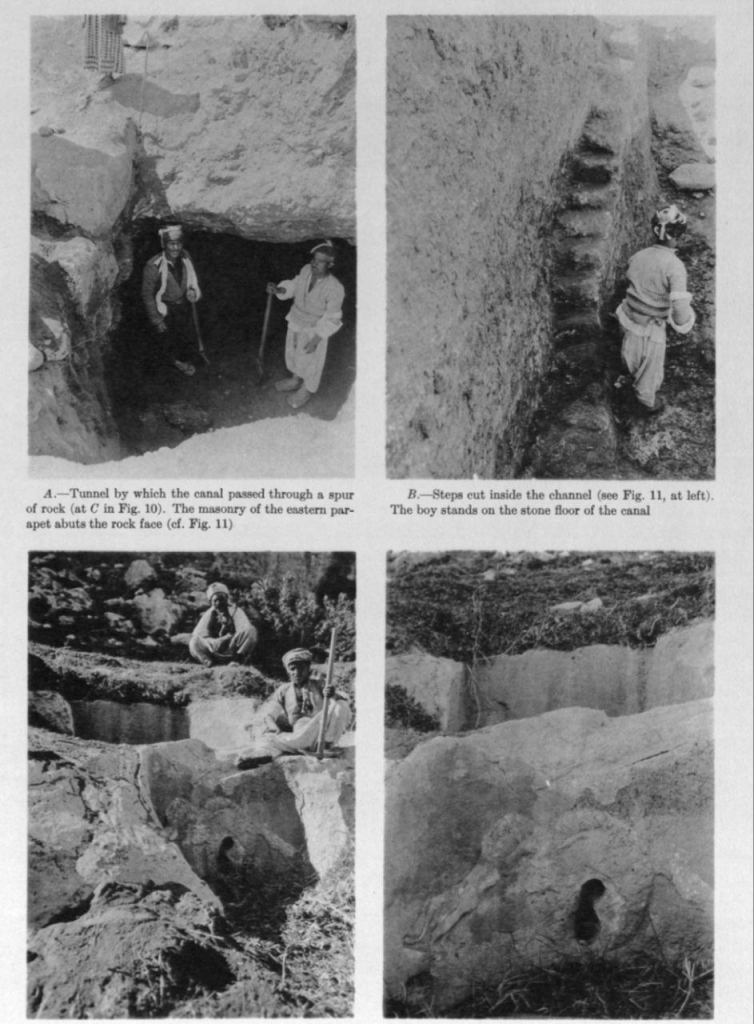The Sumerians figured out how to collect and channel the overflow of the Tigris and Euphrates riversand the rich silt that it contained and then use it to water and fertilize their farm fields. They designed complex systems of canals, with dams constructed of reeds, palm trunks and mud whose gates could be opened or closed to regulate the flow of water
The ancient Mesopotamians may have been some of the first humans to build dams. The Jarwana Dam, located in the Sheikhan district and about fifty kilometers from the city of Mosul, is one of the oldest dams in the world, as it was built 2800 years ago. And on his stones appear cuneiform writing

It was built in the Dams provided farmers with a steady source of water to irrigate crops. This allowed ancient Mesopotamians to feed a growing population.
Manmade dams create artificial lakes called reservoirs. Reservoirs can be used to store water for farming, industry, and household use. They also can be used for fishing, boating, and other leisure activities. People have used dams for many centuries to help prevent flooding.

The aqueduct is part of the larger Atrush Canal built by the Assyrian king Sennacherib between 703 and 690 BC to water Ninevah’s extensive gardens,[3] with water diverted from Khenis gorge, 50 km to the north.
An inscription on the aqueduct reads:



Sennacherib king of the world king of Assyria. Over a great distance I had a watercourse directed to the environs of Nineveh, joining together the waters…. Over steep-sided valleys I spanned an aqueduct of white limestone blocks, I made those waters flow over it

Fallen blocks in the bed of the stream

The remains of an archway, seen from the south , east

View looking downstream from quarry on west bank. An inclined way in the foreground descends to the par-tially submerged sculptures in the center. Beyond the rocks in the distance the valley opens out, and the village of Uines is seen toward the right

East end of parapet and pavement, seen from the southeast, showing (in lower right-hand corer) a row of
paving stones recessed into those beneath them

Cleaning of inscription B

Inscription B as found on the sixth bay

Large panel sculptured in relief on the cliff face

THU GOMEL GORGE. SCULPTURED BLOCK FALLEN, BROKEN, AND PARTIALLY SUBMERGED LAMASSU AND NABU

Our Sources : university of chicago
History Begins at Sumer (Philadelphia, 1956), Thirty Nine Firsts in Recorded History, by Samuel Noah Kramer, in 404 searchable pdf pages.
Selected Writings of Samuel Noah Kramer, in 570 bookmarked and searchable pdf pages.
Green، M.W. (1981). “The Construction and Implementation of the Cuneiform Writing System
Samuel Noah Kramer University of Pennsylvania Press, 1972 – History – 130 pages
- Kramer, Samuel Noah (1944). Sumerian Mythology: A Study of Spiritual and Literary Achievement in the Third Millennium B.C. American Philosophical Society. Revised edition: 1961.
- Kramer, Samuel Noah (1981). History Begins at Sumer: Thirty-Nine Firsts in Man’s Recorded History (3 ed.). University of Pennsylvania Press. I. First edition: 1956 (Twenty-Five Firsts). Second Edition: 1959 (Twenty-Seven Firsts).
- Kramer, Samuel Noah (1963). The Sumerians: Their History, Culture, and Character Samuel Noah Kramer (PDF). University of Chicago Press.
- Kramer, Samuel Noah (1967). Cradle of Civilization: Picture-text survey that reconstructs the history, politics, religion and cultural achievements of ancient Sumer, Babylonia and Assyria. Time-Life: Great Ages of Man: A History of the World’s Cultures..
- Wolkstein, Diane; Kramer, Samuel Noah (1983). Inanna, Queen of Heaven and Earth: Her Stories and Hymns from Sumer. New York: Harper & Row.
- Kramer, Samuel Noah (1988a). In the World of Sumer: An Autobiography. Wayne State University Press
- Babylon: Mesopotamia and the Birth of Civilization. Paul Kriwaczek.
Ancient Mesopotamia. Leo Oppenheim.
Ancient Mesopotamia: This History, Our History. University of Chicago.
Mesopotamia 8000-2000 B.C. Metropolitan Museum of Art.
30,000 Years of Art. Editors at Phaidon. - Treasures of the Iraq Museum Faraj Basmachi Ministry of Information, 1976 – Art, Iraqi – 426 pages
- Algaze, Guillermo, 2008 Ancient Mesopotamia at the Dawn of Civilization: the Evolution of an Urban Landscape. University of Chicago Press
- Atlas de la Mésopotamie et du Proche-Orient ancien, Brepols, 1996
- Bottéro, Jean; 1987. (in French) Mésopotamie. L’écriture, la raison et les dieux, Gallimard, coll. « Folio Histoire »,
- Bottéro, Jean (15 June 1995). Mesopotamia: Writing, Reasoning, and the Gods. Translated by Bahrani, Zainab; Van de Mieroop, Marc. University of Chicago Press.
- Edzard, Dietz Otto; 2004. Geschichte Mesopotamiens. Von den Sumerern bis zu Alexander dem Großen, München,
- Hrouda, Barthel and Rene Pfeilschifter; 2005. Mesopotamien. Die antiken Kulturen zwischen Euphrat und Tigris. München 2005 (4. Aufl.),
- Joannès, Francis; 2001. Dictionnaire de la civilisation mésopotamienne, Robert Laffont.
- Korn, Wolfgang; 2004. Mesopotamien – Wiege der Zivilisation. 6000 Jahre Hochkulturen an Euphrat und Tigris, Stuttgart,
- Matthews, Roger; 2005. The early prehistory of Mesopotamia – 500,000 to 4,500 BC, Turnhout 2005,
- Oppenheim, A. Leo; 1964. Ancient Mesopotamia: Portrait of a dead civilization. The University of Chicago Press: Chicago and London. Revised edition completed by Erica Reiner, 1977.
- Pollock, Susan; 1999. Ancient Mesopotamia: the Eden that never was. Cambridge University Press: Cambridge.
- Postgate, J. Nicholas; 1992. Early Mesopotamia: Society and Economy at the dawn of history. Routledge: London and New York.
- Roux, Georges; 1964. Ancient Iraq, Penguin Books.
- Silver, Morris; 2007. Redistribution and Markets in the Economy of Ancient Mesopotamia: Updating Polanyi, Antiguo Oriente
- Pingree, David (1998). “Legacies in Astronomy and Celestial Omens”. In Dalley, Stephanie (ed.). The Legacy of Mesopotamia. Oxford University Press.
- Stager, L. E. (1996). “The fury of Babylon: Ashkelon and the archaeology of destruction”. Biblical Archaeology Review. 22 (1).
- Stol, Marten (1993). Epilepsy in Babylonia. Brill Publishers.
- Louvre Museum
- Vatican Museums
- British Museum
- Metropolitan Museum of Art
- Rijksmuseum
- Ashmolean Museum
- Cleveland Museum of Art
- Art Institute of Chicago
- Field Museum of Natural History


